Students can Download Physics Chapter 5 Electromagnetic Waves Questions and Answers, Notes Pdf, Samacheer Kalvi 12th Physics Solutions Guide Pdf helps you to revise the complete Tamilnadu State Board New Syllabus and score more marks in your examinations.
Tamilnadu Samacheer Kalvi 12th Physics Solutions Chapter 5 Electromagnetic Waves
Samacheer Kalvi 12th Physics Electromagnetic Waves Textual Evaluation Solved
Samacheer Kalvi 12th Physics Electromagnetic Waves Multiple Choice Questions
Question 1.
The dimension of \(\frac { 1 }{ { \mu }_{ 0 }{ \varepsilon }_{ 0 } } \) is ……….
(a) [LT-1]
(b) [L2 T-2]
(c) [L-1 T]
(d) [L-2 T2]
Answer:
(b) [L2 T-2].
Question 2.
If the amplitude of the magnetic field is 3 x 10-6 T, then amplitude of the electric field for a electromagnetic waves is ……….
(a) 100 V m-1
(b) 300 V m-1
(c) 600 V m-1
(d) 900 V m-1
Answer:
(d) 900 V m-1.
Question 3.
Which of the following electromagnetic radiation is used for viewing objects through fog ……….
(a) microwave
(b) gamma rays
(c) X- rays
(d) infrared
Answer:
(d) infrared.
![]()
Question 4.
Which of the following are false for electromagnetic waves ……….
(a) transverse
(b) mechanical waves
(c) longitudinal
(d) produced by accelerating charges
Answer:
(c) longitudinal.
Question 5.
Consider an oscillator which has a charged particle and oscillates about its mean position with a frequency of 300 MHz. The wavelength of electromagnetic waves produced by this oscillator is ……….
(a) 1 m
(b) 10 m
(c) 100 m
(d) 1000 m
Answer:
(a) 1 m.
Question 6.
The electric and the magnetic field, associated with an electromagnetic wave, propagating along X axis can be represented by ……….
(a) \(\vec { E } \) = E0 \(\hat{j}\) and \(\vec { B } \) = B0 \(\hat{k}\)
(b) \(\vec { E } \) = E0 \(\hat{k}\) and \(\vec { B } \) = B0 \(\hat{j}\)
(c) \(\vec { E } \) = E0 \(\hat{i}\) and \(\vec { B } \) = B0 \(\hat{j}\)
(d) \(\vec { E } \) = E0 \(\hat{j}\) and \(\vec { B } \) = B0 \(\hat{j}\)
Answer:
(b) \(\vec { E } \) = E0 \(\hat{k}\) and \(\vec { B } \) = B0 \(\hat{j}\).
Question 7.
In an electromagnetic wave in free space the rms value of the electric field is 3 V m-1. The peak value of the magnetic field is ……….
(a) 1.414 x 10-8 T
(b) 1.0 x 10-8 T
(c) 2.828 x 10-8 T
(d) 2.0 x 10-8 T
Answer:
(a) 1.414 x 10-8 T.
Question 8.
A During the propagation of electromagnetic waves in a medium ……….
(a) electric energy density is double of the magnetic energy density
(b) electric energy density is half of the magnetic energy density
(c) electric energy density is equal to the magnetic energy density
(d) both electric and magnetic energy densities are zero
Answer:
(c) electric energy density is equal to the magnetic energy density.
Question 9.
If the magnetic monopole exists, then which of the Maxwell’s equation to be modified ……….

Answer:
(b) \(\oint { \vec { E } } \).d\(\vec { A } \) = 0
Question 10.
A radiation of energy E falls normally on a perfectly reflecting surface. The momentum transferred to the surface is ……….
(a) \(\frac { E }{ c }\)
(b) 2\(\frac { E }{ c }\)
(c) Ec
(d) \(\frac { E }{{ c }^{2}}\)
Answer:
(b) 2\(\frac { E }{ c }\).
![]()
Question 11.
Which of the following is an electromagnetic wave ……….
(a) α – rays
(b) β – rays
(c) γ – rays
(d) all of them
Answer:
(c) γ – rays.
Question 12.
Which one of them is used to produce a propagating electromagnetic wave ……….
(a) an accelerating charge
(b) a charge moving at a constant velocity
(c) a stationary charge
(d) an uncharged particle
Answer:
(a) an accelerating charge.
Question 13.
Let E = E0 sin[106 x -ωt] be the electric field of plane electromagnetic wave, the value of to is ……….
(a) 0.3 x 10-14 rad s-1
(b) 3 x 10-14 rad s-1
(c) 0.3 x 1014 rad s-1
(d) 3 x 1014 rad s-1
Answer:
(d) 3 x 1014 rad s-1.
Question 14.
Which of the following is NOT true for electromagnetic waves ……….
(a) it transport energy
(b) it transport momentum
(c) it transport angular momentum
(d) in vacuum, it travels with different speeds which depend on its frequency
Answer:
(d) in vacuum, it travels with different speeds which depend on its frequency.
![]()
Question 15.
The electric and magnetic fields of an electromagnetic wave are ……….
(a) in phase and perpendicular to each other
(b) out of phase and not perpendicular to each other
(c) in phase and not perpendicular to each other
(d) out of phase and perpendicular to each other
Answer:
(a) in phase and perpendicular to each other.
Samacheer Kalvi 12th Physics Electromagnetic Waves Short Answer Questions
Question 1.
What is displacement current?
Answer:
The current comes into play in the region in which the electric field and the electric flux are changing with time.
Question 2.
What are electromagnetic waves?
Answer:
Electromagnetic waves are non-mechanical waves which move with speed equals to the speed of light (in a vacuum).
Question 3.
Write down the integral form of modified Ampere’s circuital law.
Answer:
This law relates the magnetic field around any closed path to the conduction current and displacement current through that path.

Question 4.
Explain the concept of intensity of electromagnetic waves.
Answer:
The energy crossing per unit area per unit time and perpendicular to the direction of propagation of electromagnetic wave is called the intensity.
Intensity, I = \(\left< u \right> \)c
Question 5.
What is meant by Fraunhofer lines?
Answer:
- When the spectrum from the sun is examined, it consists of a large number of dark lines. These dark lines in the solar spectrum are known as Fraunhofer lines.
- The absorption spectra for various materials are compared with the Fraunhofer lines in the solar spectrum which helps to identify elements present in the sun’s atmosphere.
Samacheer Kalvi 12th Physics Electromagnetic Waves Long Answer Questions
Question 1.
Write down Maxwell equations in integral form.
Answer:
Maxwell’s equations in integral form:
Electrodynamics can be summarized into four basic equations, known as Maxwell’s equations. These equations are analogous to Newton’s equations in mechanics. Maxwell’s equations completely explain the behaviour of charges, currents and properties of electric and magnetic fields. So we focus here only in integral form of Maxwell’s equations:
(i) First equation is nothing but the Gauss’s law. It relates the net electric flux to net electric charge enclosed in a surface. Mathematically, it is expressed as

Where \(\vec { E } \) is the electric field and Qenclosed is the charge enclosed. This equation is true for both discrete or continuous distribution of charges. It also indicates that the electric field lines start from positive charge and terminate at negative charge. This implies that the electric field lines do not form a continuous closed path. In other words, it means that isolated positive charge or negative charge can exist.
(ii) Second equation has no name. But this law is similar to Gauss’s law in electrostatics. So this law can also be called as Gauss’s law in magnetism. The surface integral of magnetic field over a closed surface is zero. Mathematically,
\(\oint { \vec { B } } \).d\(\vec { A } \) = 0
where \(\vec { B } \) is the magnetic field. This equation implies that the magnetic lines of force form a continuous closed path. In other words, it means that no isolated magnetic monopole exists.
(iii) Third equation is Faraday’s law of electromagnetic induction. This law relates electric field with the changing magnetic flux which is mathematically written as
\(\oint { \vec { E } } \).d\(\vec { l } \) = \(\frac { d }{ dt }\) ΦB
where \(\vec { E } \) is the electric field. This equation implies that the line integral of the electric field around any closed path is equal to the rate of change of magnetic flux through the closed path bounded by the surface.
(iv) Fourth equation is modified Ampere’s circuital law. This is also known as ampere- Maxwell’s law. This law relates the magnetic field around any closed path to the conduction current and displacement current through that path.
![]()
Where \(\vec { B } \) is the magnetic field. This equation shows that both conduction and also displacement current produces magnetic field. These four equations are known as Maxwell’s equations in electrodynamics.
![]()
Question 2.
Write short notes on
(a) microwave
(b) X-ray
(c) radio waves
(d) visible spectrum.
Answer:
(a) Microwave:
- Produced by electromagnetic oscillators in electric circuits.
- The wavelength range is 1 × 10-3 to 3 × 10-1 m
- The frequency range is 3 × 1011 Hz to 1 × 109 Hz
- It obeys reflection and polarisation.
- Used in Radar, Microwave oven, long-distance wireless communication.
(b) X-Ray:
- Produced when high-speed electrons are suddenly decelerated by high atomic number target X-rays are produced.
- An X-ray can also be produced by electronic transitions among the innermost orbit of atoms.
- The wavelength range is 10-13 m to 10-8 m
- The frequency range is 3 × 1021 Hz to 1 × 1016 Hz
- Used to study crystal structure, detect faults, cracks, flaws, and holes in finished metal products. In medicine it is used to detect fractures; stones in kidneys.
(c) Radio waves:
- It is produced by oscillators in electric circuits. It obeys reflection and diffraction.
- Its wavelength is 1 × 10-1m to 1 × 104m.
- Its Frequency is 3 × 109 Hz to 3 × 104 Hz.
- It is used in radio and television communication systems.
- In cellular phones to transmit voice communication in the ultra-high frequency band.
(d) Visible Spectrum:
- Produced by incandescent bodies and also it is radiated by excited atoms.
- Wavelength range is 4 × 10-7 m to 7 × 10-7 m
- Frequency range are 7 × 1014 Hz to 4 × 1014 Hz
- Used to study structure of molecules, the arrangement of electrons in external shells of atom and sensation of our eyes.
Question 3.
Discuss briefly the experiment conducted by Hertz to produce and detect electromagnetic spectrum.
Answer:
Production of the electromagnetic waves-Hertz experiment: Maxwell’s prediction was experimentally confirmed by Heinrich Rudolf Hertz in 1888. The experimental setup used is shown in the figure.
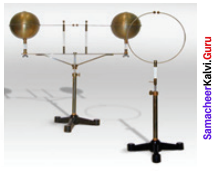
It consists of two metal electrodes which are made of small spherical metals. These are connected to larger spheres and the ends of them are connected to an induction coil with very large number of turns. This is to produce a very high electromotive force (emf). Since the coil is maintained at very high potential, air between the electrodes gets ionized and spark (spark means discharge of electricity) is produced. The gap between electrodes (ring type – not completely closed and has a small gap in between) kept at a distance also gets a spark.
This implies that the energy is transmitted from the electrode to the receiver (ring electrode) as a wave, known as electromagnetic waves. If the receiver is rotated by 90° – then no spark is observed by the receiver. This confirms that electromagnetic waves are transverse waves as predicted by Maxwell. Hertz detected radio waves and also computed the speed of radio waves which is equal to the speed of light (3 x 108 m s-1).
![]()
Question 4.
Explain Maxwell’s modification of Ampere’s circuital law.
Answer:
Maxwell argued that a changing electric field between the capacitor plates must induce a magnetic field. As currents are the usual sources of magnetic fields, a changing electric field must be associated with a current. Maxwell called this current as of the displacement current.
If ‘A’ be the area of the capacitor plates and ‘q’ be the charge on the plates at any instant ‘t’ during the charging process, then the electric field in the gap will be
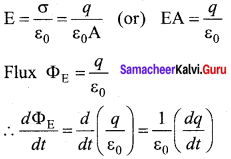
But \(\frac { dq }{ dt }\) is the rate of change of charge on the capacitor plates. It is called displacement current and is given by Id = \(\frac { dq }{ dt }\) = ε0 \(\frac {{ dΦ }_{E}}{ dt }\)
This is the missing term in Ampere’s Circuital Law. The total current must be the sum of the conduction current Ic and the displacement current Id. Thus, I = Ic + Id = Ic + ε0 \(\frac {{ dΦ }_{E}}{ dt }\).
Hence, the modified form of the Ampere’s Law is

Question 5.
Write down the properties of electromagnetic waves.
Answer:
Properties of electromagnetic waves:
(i) Electromagnetic waves are produced by an accelerated charge.
(ii) Electromagnetic waves do not require any medium for propagation. So electromagnetic wave is a non-mechanical wave.
(iii) Electromagnetic waves are transverse in nature. This means that the oscillating electric field vector, oscillating magnetic field vector and propagation vector (gives direction of propagation) are mutually perpendicular to each other.
(iv) Electromagnetic waves travel with speed which is equal to the speed of light in vacuum or free space, c = \(\frac { 1 }{ \sqrt { { \varepsilon }_{ 0 }{ \mu }_{ 0 } } } \) 3 x 108 ms-1
(v) The speed of an electromagnetic wave is less than speed in free space or vacuum, that is, v < c. In a medium of refractive index,
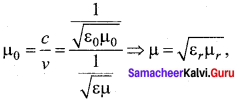
(vi) Electromagnetic waves are not deflected by electric field or magnetic field.
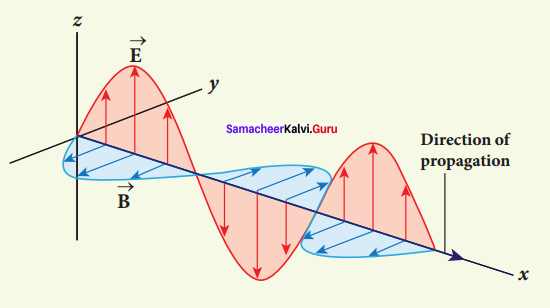
(vii) Electromagnetic waves can show interference, diffraction and can also be polarized.
(viii) The energy density (energy per unit volume) associated with an electromagnetic wave propagating in vacuum or free space is
u = \(\frac { 1 }{ 2 }\) ε0 E2 + \(\frac { 1 }{{ 2µ }_{0}}\) Bε2
Where, \(\frac { 1 }{ 2 }\) ε0 E2 = uE is the energy density in an electric field and \(\frac { 1 }{{ 2µ }_{0}}\) Bε2 = uB is the energy density in a managnetic field.
Since, E = Bc ⇒ uB = uE.
The energy density of the electromagnetic wave is = ε E2 = -B2
(ix) The average energy density for electromagnetic wave, \(\left< u \right> \) = \(\frac { 1 }{ 2 }\) ε0 E2 = \(\frac { 1 }{ 2 }\) \(\frac { 1 }{{ µ }_{0}}\) Bε2
(x) The energy crossing per unit area per unit time and perpendicular to the direction of propagation of the electromagnetic wave is called the intensity.
Intensity, I = \(\left< u \right> \)c
(xi) Like other waves, electromagnetic waves also carry energy and momentum. For the electromagnetic wave of energy U propagating with speed c has linear momentum which is given by = \(\frac { Energy }{ speed }\) = \(\frac { U }{ c }\). The force exerted by an electromagnetic wave on unit area speed of a surface is called radiation pressure.
(xii) If the electromagnetic wave incident on a material surface is completely absorbed, then the energy delivered is U and momentum imparted on the surface is p = \(\frac { U }{ c }\).
(xiii) If the incident electromagnetic wave of energy U is totally reflected from the surface, then the momentum delivered to the surface is ∆p = \(\frac { U }{ c }\) – \(\left( -\frac { U }{ c } \right) \) = 2\(\frac { U }{ c }\).
(xiv) The rate of flow of energy crossing a unit area is known as pointing vector for electromagnetic waves, which is \(\vec { S } \) = \(\frac { 1 }{{ µ }_{0}}\) (\(\vec { E } \)×\(\vec { B } \)) = c2ε0 (\(\vec { E } \)×\(\vec { B } \)).The unit for pointing vector is W m-2. The pointing vector at any point gives the direction of energy transport from that point.
(xv) Electromagnetic waves carry not only energy and momentum but also angular momentum.
![]()
Question 6.
Discuss the source of electromagnetic waves.
Answer:
Sources of electromagnetic waves:
Any stationary source charge produces an only an electric field. When the charge moves with uniform velocity, it produces a steady current which gives rise to the magnetic field (not time-dependent, only space-dependent) around the conductor in which the charge flows.
If the charged particle accelerates, in addition to electric field it also produces a magnetic field. Both electric and magnetic fields are time varying fields. Since the electromagnetic waves are transverse waves, the direction of propagation of electromagnetic waves is perpendicular to the plane containing electric and magnetic field vectors.
Any oscillatory motion is also an accelerating motion, so, when the charge oscillates (oscillating molecular dipole) about their mean position, it produces electromagnetic waves.
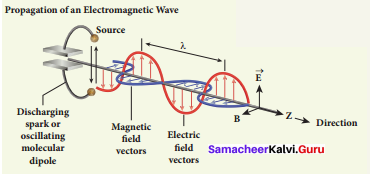
Suppose the electromagnetic field in free space propagates along the z-direction, and if the electric field vector points along y axis then the magnetic field vector will be mutually perpendicular to both the electric field and the propagation vector direction,
which means
Ey = E0 sin (kz – ωt)
Bx = B0 sin (kz – ωt)
Where E0 and B0 are the amplitude of the oscillating electric and magnetic field, k is a wave number, ω is the angular frequency of the wave, and \(\hat{k}\) (unit vector, here it is called propagation vector) denotes the direction of propagation of the electromagnetic wave.
Note that both electric field and magnetic field oscillate with a frequency (frequency of the electromagnetic wave) which is equal to the frequency of the source (here, the oscillating charge is the source for the production of electromagnetic waves). In free space or in a vacuum, the ratio between E0 and B0 is equal to the speed of the electromagnetic wave, which is equal to the speed of light c.
c = \(\frac {{ E }_{0}}{ { B }_{0} }\)
In any medium, the ratio of E0 and B0 is equal to the speed of the electromagnetic wave in that medium, mathematically, it can be written as
v = \(\frac {{ E }_{0}}{ { B }_{0} }\) < c
Further, the energy of electromagnetic waves comes from the energy of the oscillating charge.
Question 7.
What is emission spectra? Give their types.
Answer:
Emission spectra: When the spectrum of the self-luminous source is taken, we get the emission spectrum. Each source has its own characteristic emission spectrum. The emission spectrum can be divided into three types:
(i) Continuous emission spectra (or continuous spectra):
If the light from the incandescent lamp (filament bulb) is allowed to pass through a prism (simplest spectroscope), it splits into seven colours. Thus, it consists of wavelengths containing all the visible colours ranging from violet to red. Examples: the spectrum obtained from carbon arc, incandescent solids, liquids gives continuous spectra.

(ii) Line emission spectrum (or line spectrum):
Suppose light from the hot gas is allowed to pass through a prism, line spectrum is observed. Line spectra are also known as discontinuous spectra. The line spectra are sharp lines of definite wavelengths or frequencies.
Such spectra arise due to excited atoms of elements. These lines are the characteristics of the element which means it is different for different elements. Examples: spectra of atomic hydrogen, helium, etc.

(iii) Band emission spectrum (or band spectrum):
Band spectrum consists of several very closely spaced spectral lines which overlapped together forming specific bands which are separated by dark spaces, known as band spectra. This spectrum has a sharp edge at one end and fades out at the other end.
Such spectra arise when the molecules are excited. Band spectrum is the characteristic of the molecule hence, the structure of the molecules can be studied using their band spectra. Examples, spectra of hydrogen gas, ammonia gas in the discharge tube etc.
![]()
Question 8.
What is absorption spectra? Give their types.
Answer:
Absorption spectra: When light is allowed to pass through a medium or an absorbing substance then the spectrum obtained is known as the absorption spectrum. It is the characteristic of absorbing substances. The absorption spectrum is classified into three types:
(i) Continuous absorption spectrum:
When the light is passed through a medium, it is dispersed by the prism, we get a continuous absorption spectrum. For instance, when we pass white light through a blue glass plate, it absorbs everything except blue. This is an example of a continuous absorption spectrum.
(ii) Continuous absorption spectrum:
When light from the incandescent lamp is passed through cold gas (medium), the spectrum obtained through the dispersion due to prism is line absorption spectrum. Similarly, if the light from the carbon arc is made to pass through sodium vapour, -a continuous spectrum of carbon arc with two dark lines in the yellow region of sodium vapour is obtained.

(iii) Band absorption spectrum:
When the white light is passed through the iodine vapour, dark bands on the continuous bright background are obtained. This type of band is also obtained when white light is passed through a diluted solution of blood or chlorophyll or through certain solutions of organic and inorganic compounds.
Samacheer Kalvi 12th Physics Electromagnetic Waves Numerical problems
Question 1.
Consider a parallel plate capacitor whose plates are closely spaced. Let R be the radius of the plates and the current in the wire connected to the plates is 5 A, calculate the displacement current through the surface passing between the plates by directly calculating the rate of change of flux of electric field through the surface.
Solution:
The conduction current Ic = 5A
According to Gauss’s Law,
Electric flux, θE = \(\frac { q }{{ ε }{0}}\)
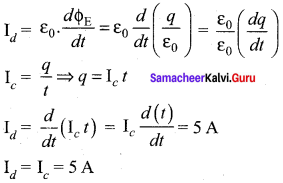
Question 2.
A transmitter consists of an LC circuit with an inductance of 1 μH and capacitance of 1 μF. What is the wavelength of the electromagnetic waves it emits?
Solution:
Inductance of LC circuit, L = 1 μH = 1 × 10-6 H
Capacitance of LC circuit, C = 1 μF = 1 × 10-6 F
Wave length of the electromagnetic wave X = λ = \(\frac { C }{ f }\)
Velocity of light C = 3 x 108 ms-1
Frequency of electromagnetic wave, f = \(\frac { 1 }{ 2\pi \sqrt { LC } } \)

= 0.1884 × 104
λ = 18.84 × 102 m
Question 3.
A pulse of light of duration 10-6 s is absorbed completely by a small object initially at rest. If the power of the pulse is 60 x 10-3 W, calculate the final momentum of the object.
Solution:
Duration of the absorption of the light pulse, t = 10-6 s
Power of the pulse P = 60 x 10-3 W
Final momentum of the object, P = \(\frac { U }{ c }\)
Velocity of light, C = 3 x 108
Energy U = power x time
Momentum, P = \(\frac{60 \times 10^{-3} \times 10^{-6}}{3 \times 10^{8}}\)
P = 20 × 10-17 kg m s-1
![]()
Question 4.
Let an electromagnetic wave propagation along the x-direction, the magnetic field oscillates at a frequency of 1010 Hz and has an amplitude of 10-5 T, acting along the y-direction. Then, compute the wavelength of the wave. Also, write down the expression for the electric field in this case.
Solution:
Frequency of electromagnetic wave, v = 1010 Hz
Amplitude of Oscillating magnetic field, B0 = 10-5 T
Wave length of the wave, λ = \(\frac { C }{ f }\) = \(\frac{3 \times 10^{8}}{10^{10}}\) = 3x 10-2 m
Amplitude of oscillating electric field, E0 = B0 C
C = \(\frac {{ E }_{0}}{ { B }_{0} }\)
E0 = 10-5 × 3 × 108
E0 = 3 × 103 = NC-1
Experession for electric field in Oscillataing wave
E = E0 sin (kx -wt)
K = \(\frac { 2π }{ λ }\) = \(\frac{2 \times 3.14}{3 \times 10^{-2}}\) = 209 x 102
W = 2πƒ = 2 × 3.14 x 1010 = 6.28 × 1010
\(\vec { E } \) = 3 x 103 sin (2.09 × 102 x – 6.28 × 1010 t) \(\hat{i}\) NC-1.
Question 5.
If the relative permeability and relative permittivity of the medium is 1.0 and 2.25, respectively. Find the speed of the electromagnetic wave in this medium.
Solution:
Relative permeability of the medium, μr = 1
Relative permittivity of the medium, εr = 2.25

Speed of electromagnetic wave, v = \(\frac { 1 }{ \sqrt { \mu \varepsilon } } \)
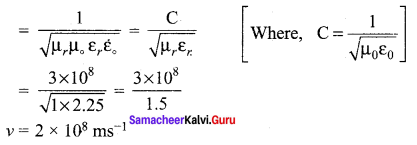
Samacheer Kalvi 12th Physics Electromagnetic Waves Additional Questions Solved
I Choose the Correct Answer from the Following
Question 1.
The speed of electromagnetic waves in vacuum is given by
(a) μ0ε0
(b) \(\sqrt { { \mu }_{ 0 }{ \varepsilon }_{ 0 } } \)
(c) \(\frac { 1 }{ { \mu }_{ 0 }{ \varepsilon }_{ 0 } } \)
(d) \(\frac { 1 }{ \sqrt { { \mu }_{ 0 }{ \varepsilon }_{ 0 } } } \)
Answer:
(d) \(\frac { 1 }{ \sqrt { { \mu }_{ 0 }{ \varepsilon }_{ 0 } } } \).
Question 2.
In an electromagnetic wave, the electric field vector E and magnetic field vector B are
(a) Perpendicular to each other
(b) Parallel to each other
(c) at 45° to each other
(d) can have any angle between them
Answer:
(a) Perpendicular to each other.
Question 3.
If E and B be the electric and magnetic field vectors of an electromagnetic wave, then the propagation of the wave is along the direction of
(a) E
(b) B
(c) E x B
(d) Bx E
Answer:
(c) E x B.
Question 4.
In which of the following sequences are the electro magnetic radiations in decreasing order of wavelength
(a) Infrared, radio, X-rays, visible
(b) Radio, infrared, visible, X-rays
(c) Radio, visible, infrared, X-rays
(d) X-rays, visible, infrared, radio
Answer:
(b) Radio, infrared, visible, X-rays
Question 5.
Ozone layer absorbs
(a) Infrared radiation
(b) Microwaves
(c) Radio waves
(d) UV radiation
Answer:
(d) UV radiation.
![]()
Question 6.
A RADAR beam consists of
(a) X-rays
(b) IR rays
(c) UV rays
(d) Microwaves
Answer:
(d) Microwaves.
Question 7.
Which of the following radiations has the longest wavelength?
(a) Radio waves
(b) IR radiation
(c) X-ray
(d) Visible light
Answer:
(a) Radio waves.
Question 8.
TV waves have a wavelength range of 1 – 10 metre. Their frequency range in MHz is
(a) 300 – 3000
(b) 3 – 3000
(c) 30 – 300
(d) 3 – 30
Answer:
(c) 30 – 300.
Question 9.
The electromagnetic radiation most prevalent in the atmosphere is
(a) Visible light
(b) Infrared
(c) UV
(d) Radio waves
Answer:
(b) Infrared.
Question 10.
Consider an electric charge oscillating with frequency of 10MHz. The radiation emitted will have a wavelength eqal to
(a) 20m
(b) 30m
(c) 40m
(d) 10m
Answer:
(b) 30m
Hint:
Wave length, λ = \(\frac { C }{ v }\) = \(\frac{3 \times 10^{8}}{10 \times 10^{6}}\)
= 0.3x 102 = 30m.
![]()
Question 11.
The frequencies of X-rays, v-rays and UV rays are respectively a, b and c. Then
(a) a < b, b < c
(b) a < b, b > c
(c) a > b, b > c
(d) a > b, b < c
Answer:
(b) a < b, b > c .
Question 12.
The greenhouse effect is caused by
(a) UV rays
(b) X-rays
(c) Gamma rays
(d) IR rays
Answer:
(d) IRrays.
Question 13.
If a capacitance C is connected across an inductance L, then the angular frequency is
(a) \( \sqrt{LC} \)
(b) LC
(c) \(\sqrt { \frac { L }{ C } } \)
(d) \(\sqrt { \frac { 1 }{ LC } } \)
Answer:
(d) \(\sqrt { \frac { 1 }{ LC } } \).
Question 14.
If ε0 and μ0 are the electric permitivity and permeability of free space, ε and μ are the corresponding quantities in a medium, then the index of refraction of the medium is
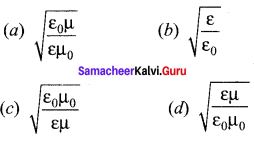
Answer:
(d) \(\sqrt { \frac { \varepsilon \mu }{ { \varepsilon }_{ 0 }{ \mu }_{ 0 } } } \)
Hint:
Index of refraction

Question 15.
Dimensions of \(\frac { 1 }{ { \mu }_{ 0 }{ \varepsilon }_{ 0 } } \) where symbols have their usual meaning, are
(a) [L-2 T2]
(b) [L2 T-2]
(c) [LT-1]
(d) [L-1 T]
Answer:
(b) [L2 T-2]
Hint:

Question 16.
If λv, λx, λm, represent the wavelength of visible light, X-rays and microwaves, respectively, then
(a) λm >λv > λx
(b) λm > λx > λv
(c) λv > λm > λx
(d) λv > λx > λm
Answer:
(a) λm >λv > λx.
![]()
Question 17.
The ratio of the amplitude of magnetic field to the amplitude of electric field for an electromagnetic wave propagating in a vacuum is equal to
(a) the speed of light in vacuum
(b) reciprocal of the speed of light in a vacuum
(c) the ratio of magnetic permeability to electric susceptibility in vacuum
(d) unity
Answer:
(b) reciprocal of the speed of light in vacuum.
Question 18.
Which of the following radiations forms part of the electromagnetic spectrum?
(a) alpha rays
(b) Beta rays
(c) Gamma rays
(d) Cathode rays
Answer:
(c) Gamma rays.
Question 19.
The ozone layer absorbs radiation of wavelegnths
(a) Less than 3 x 10-7 m
(b) More than 3 x 10-7 m
(c) Less than 3 x 10-5 m
(d) More than 3 x 10-5 m
Answer:
(a) Less than 3 x 10-7 m.
Question 20.
It is possible to take pictures of those objects which are not fully visible to the eye using camera films sensitive to
(a) UV rays
(b) IR rays
(c) Microwaves
(d) Radio waves
Answer:
(b) IRrays.
![]()
Question 21.
An electromagnetic wave has wavelength 10cm. It is in the
(a) Visible region
(b) Radio region
(c) UV region
(d) X-ray region
Answer:
(b) Radio region.
Question 22.
Electromagnetic radiation of frequency 3 x 105 MHz lies in the
(a) Radio wave region
(b) Visible region
(c) IR region
(d) Microwave region
Answer:
(d) Microwave region.
Question 23.
Radio waves and visible light in a vacuum have
(a) Same wavelength but different velocities
(b) Same velocity but the different wavelength
(c) Different velocities and different wavelengths
(d) Same velocity and same wavelength
Answer:
(b) Same velocity but different wavelength.
Question 24.
Which of the following has maximum frequency?
(a) X-rays
(b) IR rays
(c) UV rays
(d) Radio waves
Answer:
(a) X-rays.
Question 25.
Electromagnetic radiation of frequency 1 GHz lies in
(a) UV region
(b) IR region
(c) Visible region
(d) Microwave region
Answer:
(d) Microwave region.
![]()
Question 26.
An electromagnetic wave of frequency v = 3.0MHz passes from vacuum into a dielectric medium with permitivity s = 4.0 ε0. Then
(a) Wavelength is doubled and frequency becomes half
(b) Wavelength is doubled and the frequency remains unchanged.
(c) Wavelength and frequency both remain unchanged
(d) Wavelength is halved and frequency remains unchanged.
Answer:
(d) Wavelength is halved and frequency remain unchanged.
Hint:
When a wave goes from one medium to another, its frequency remains unchanged.
According to equation C = \(\frac { 1 }{ \sqrt { \mu \varepsilon } } \), the speed is halved. Therefore, the wavelength is also halved.
Question 27.
The frequency of a wave is 6 x 1015 Hz. The wave is
(a) Radio wave
(b) Microwave
(c) X-ray
(d) UV rays
Answer:
(d) UV rays.
Question 28.
In an electromagnetic wave the phase difference between electric field \(\vec { E } \) and magnetic field \(\vec { B } \) is
(a) \(\frac { π }{ 4 }\)
(b) \(\frac { π }{ 2 }\)
(c) π
(d) zero
Answer:
(d) Zero.
Question 29.
The energy in an electromagnetic wave is
(a) Wholly shared only by electric field vector
(b) Wholly shared only by magnetic field vector
(c) Equally divided between the electric and magnetic field
(d) Zero
Answer:
(c) Equally divided between electric and magnetic field.
Question 30.
Electromagnetic waves are produced by
(a) Atoms and molecules in an electrical discharge
(b) Electric device
(c) Accelerated charges
(d) Molecules of hot bodies
Answer:
(c) Accelerated charges.
II Fill in The Blanks
Question 1.
Electromagnetic waves are ……………
Answer:
Transverse in nature
Question 2.
An accelerated charge is a source of ……………
Answer:
Electromagnetic radiation
Question 3.
In electromagnetic waves, the angle between electric and magnetic field vectors is ……………
Answer:
90°
Question 4.
The electromagnetic waves travel in vacuum or free space with a velocity of ……………
Answer:
3 x 108 ms-1
Question 5.
The existance of electromagnetic waves was confirmed experimentally by ……………
Answer:
Hertz.
![]()
Question 6.
Radio frequency wave have a wavelength ranging from ……………to ……………
Answer:
10 m to 104 m
Question 7.
The waves that are used in radio and television communication system is ……………
Answer:
Radio waves
Question 8.
The frequency range of X-rays is from ……………
Answer:
3 x 1018 Hz to 1016 Hz
Question 9.
Higher frequencies upto 54 mHz are used for ……………
Answer:
Short wave brands
Question 10.
The wave that is used in a radar communication system is ……………
Answer:
Microwaves.
![]()
Question 11
…………… rays are used to detect forged documents.
Answer:
UV-rays.
Question 12
…………… is used for treatment of cancer.
Answer:
γ – rays (gamma rays).
Question 13.
The structure of atoms can be studied with ……………
Answer:
X-rays
Question 14.
When the light emitted directly from a source is examined with a spectrometer, the spectrum obtained is …………… spectrum.
Answer:
Emission
Question 15.
When the light emitted from a source is made to pass through an absorbing material, the spectrum obtained is called …………… spectrum.
Answer:
Absorption.
![]()
Question 16.
Electromagnetic disturbance can be propagated through space ……………
Answer:
without the help of a material medium.
Question 17.
The velocity of electromagnetic wave is given by the relation ……………
Answer:
C = \(\frac { 1 }{ \sqrt { { { \mu }_{ 0 } }{ { \varepsilon }_{ 0 } } } } \)
III Match the following
Question 1.
(i) Light – (a) Medical surgery
(ii) Laser – (b) Law of induction
(iii) Radar – (c) Electromagnetic waves
(iv) Maxwell – (d) Defence (detection system)
Answer:
(i) → (c)
(ii) → (a)
(iii) → (d)
(iv) → (b)
Question 2.
(i) Gauss Law – (a) Electromagnetic induction
(ii) Faraday’s Law – (b) φ =\(\frac { q }{{ ε }_{0}}\)
(iii) Speed of light – (c) Electromagnetic oscillators
(iv) Microwaves – (d) 3 x 108 ms-1
Answer:
(i) → (b)
(ii) → (a)
(iii) → (d)
(iv) → (c)
Question 3.
(i) Gamma ray – (a) Structure of molecules
(ii) Visible light – (b) Treatment of cancer
(iii) UV radiation – (c) Detecting fractures
(iv) X-rays – (d) Destroy bacteria
Answer:
(i) → (b)
(ii) → (a)
(iii) → (d)
(iv) → (c)
![]()
Question 4.
(i) Continuous emission spectra – (a) Atomic hydrogen
(ii) Line emission spectra – (b) Ammonia gas
(iii) Band emission spectra – (c) Incandescent solids
(iv) Band absorption spectra – (d) Blood (or) chlorophyl
Answer:
(i) → (c)
(ii) → (a)
(iii) → (b)
(iv) → (d)
IV Assertion and Reason Questions
(a) If both assertion and reason are true and the reason is the correct explanation of the assertion.
(b) If both assertion and reason are true but the reason is not the correct explanation of the assertion.
(c) If assertion is true but-reason is false.
(d) If the assertion and reason both are false.
(e) If the assertion is false but reason is true.
Question 1.
Assertion: In the Hertz experiment, the electric vector of radiation produced by the source gap is parallel to the gap.
Reason: Production of sparks between the detector gap is maximum when it is placed perpendicular to the source gap.
Answer:
(c) If the assertion is true but reason is false.
Explanation:
Hertz experimentally observed that the production of spark between the detection gap is maximum when it is placed parallel to source gap. This means that the electric vector of radiation produced by the source gap is parallel to the two gaps.
Question 2.
Assertion: Ultraviolet radiation is of higher frequency waves that are dangerous to a human being.
Reason: Ultraviolet radiation are absorbed by the atmosphere.
Answer:
(b) If assertion and reason both are true but the reason is not the correct explanation of the assertion.
Explanation:
The wavelength of these waves ranges between 6 x 10-10m to 4 x 10-7 m that is smaller wavelength and higher frequency. They are absorbed by the atmosphere and convert oxygen into ozone. They cause skin diseases and they are harmful to eye and cause permanent blindness.
Question 3.
Assertion: Only microwaves are used in RADAR.
Reason: Because microwaves have a very small wavelengths.
Answer:
(a) If assertion and reason both are true and reason is the correct explanation of the assertion.
Explanation:
In a RADAR, a beam signal is needed in particular direction which is possible if wavelength of wave is very small. Since the wavelength of microwaves is a few millimeter, hence they are used in RADAR.
Question 4.
Assertion: Radio waves bend in a magnetic field.
Reason: Radio waves are electromagnetic in nature.
Answer:
(a) If assertion and reason both are true and reason is the correct explanation of the assertion.
![]()
Question 5.
Assertion:
In the visible spectrum of light, red light is more energetic than green light.
Reason:
The wavelength of red light is more than that of green light.
Answer:
(a) If assertion and reason both are true and the reason is the correct explanation of the assertion.
Samacheer Kalvi 12th Physics Electromagnetic Waves Short Answer Questions
Question 1.
Name the scientist who first predicted the existence of electromagnetic waves.
Answer:
James Clerk Maxwell was first predicted the existence of EM waves.
Question 2.
Distinguish between conduction current and displacement current.
Answer:
Conduction Current:
- It is due to the flow of electrons in a circuit.
- It exists even if electrons flow at a uniform rate.
Displacement Current:
- It is due to the time-varying electric field.
- It does not exist under steady conditions.
Question 3.
What oscillates in electromagnetic waves?
Answer;
In EM waves, electric and magnetic fields oscillate in mutually perpendicular directions. These waves are transverse in nature.
Question 4.
Name the basic source of electromagnetic waves.
Answer:
An electric dipole is a basic source of electromagnetic waves.
Question 5.
State Maxwell’s equations.
Answer:
The whole study of electricity and magnetism can be described mathematically with the help of four fundamental equations, called Maxwell’s equations. These are stated as follows:
- Gauss law of electrostatics : \(\oint { \vec { E } } \).\(\vec { d } \)s = 0 \(\frac { q }{{ ε }{0}}\)
- Gauss law of magnetism: \(\oint { \vec { E } } \).\(\vec { d } \)s = 0
- Faraday’s Law of electromagnetic induction: \(\oint { \vec { E } } \).\(\vec { d } \)l = – \(\frac{d \phi_{\mathrm{B}}}{d t}\) = –\(\frac { d }{ dt }\) \(\left[ \oint { \vec { B. } \vec { d } s } \right] \)
- Modified ampere’s circuital Law: \(\oint { \vec { E } } \).\(\vec { d } \)l = μ0 \(\left[\mathrm{I}_{\mathrm{C}}+\varepsilon_{0} \frac{d \phi_{\mathrm{E}}}{d t}\right]\)
![]()
Question 6.
What is the electromagnetic spectrum?
Answer:
The orderly distribution of electromagnetic radiations of all types according to their wavelength or frequency into distinct groups having widely differing properties is called the electromagnetic spectrum.
Question 7.
Define spectrum.
Answer:
The definite pattern of colours obtained on the screen after dispersion is called a spectrum.
Question 8.
Write down the concept of the black body spectrum.
Answer:
When an object bums, it emits colours. That is, it emits electromagnetic radiation which depends on temperature. If the object becomes hot then it glows in red colour. If the temperature of the object is further increased then it glows in reddish-orange colour and becomes white when it is hottest. The spectrum usually called as black body spectrum.
Question 9.
How are radio waves produced?
Answer:
Radiowaves are produced due to the accelerated motion of electrons in conducting wires or oscillating circuits.
Question 10.
How are X-rays produced?
Answer:
X-rays are produced due to the sudden deceleration of fast-moving electrons by a metal target.
Question 11.
How are microwaves produced?
Answer:
Microwaves are produced due to oscillating currents in special vacuum tubes like Klystroms.
Question 12.
What is the ‘Greenhouse effect’?
Answer:
The greenhouse effect is the phenomenon which keeps the earth’s surface warm at night. The earth reflects back infrared part of solar radiation. Infra-red rays are reflected back by low lying clouds and lower atmosphere and keep the earth’s surface warm at night.
![]()
Question 13.
Why are microwaves used in RADAR?
Answer:
Microwaves have wavelength of the order of a few millimetres. Due to their short wavelengths, these are not diffracted (bent) much by objects of normal dimensions. So they can be transmitted as a beam in a particular direction.
Question 14.
Write down the uses of radiowaves?
Answer:
It is used in radio and television communication systems and also in cellular phones to transmit voice communication in the ultra-high frequency band.
Question 15.
Write down the uses of radiowaves?
Answer:
It is used in radar systems for aircraft navigation, speed of the vehicle, microwave oven for cooking and very long-distance wireless communication through satellites.
Question 16.
Write uses of IR rays (or) infra-red radiations.
Answer:
It is used to produce dehydrated fruits; in green houses to keep the plants warm, heat therapy for muscular pain or sprain, TV remote as a signal carrier, to look through haze fog or mist and used in night vision or infrared photography.
Question 17.
Write down the uses of UV rays (or) Ultraviolet radiations.
Answer:
It is used to destroy bacteria, sterilizing surgical instruments, burglar alarms, detect invisible writing, finger prints and also in the study of molecular structure.
![]()
Question 18.
What are the uses of X-rays?
Answer:
X-rays are used extensively in studying structures of inner atomic electron shells and crystal structures. It is used in detecting fractures, diseased organs, formation of bones and stones, observing the progress of healing bones. Further, in a finished metal product, it is used to detect faults, cracks, flaws, and holes.
Question 19.
What is the emission spectrum? Write its types.
Answer:
When the spectrum of the self-luminous sources is taken, we get the emission spectrum. Each source has its own characteristic emission spectrum. The emission spectrum can be divided into
three types:
- Continuous emission spectra.
- Line emission spectrum (or line spectrum).
- Band emission spectrum (or band spectrum).
Question 20.
What are the absorption spectrum? Write its types
Answer:
When light is allowed to pass through a medium or an absorbing substance then the spectrum .obtained is known as absorption spectrum. It is the characteristic of absorbing substances.
The absorption spectrum is classified into three types:
- Continuous absorption spectrum.
- Line absorption spectrum.
- Band absorption spectrum.
Samacheer Kalvi 12th Physics Electromagnetic Waves Long Answer Questions
Question 1.
Write short notes on
(a) Infrared radiation
(b) Ultraviolet radiation
(c) Gamma radiation
Answer:
(a) Infrared radiation:
It is produced from hot bodies (also known as heat waves) and also when the molecules undergo rotational and vibrational transitions. The wavelength range is 8 x 10-7 m to 5 x 103 m and the frequency range is 4 x 1014 Hz to 6 x 1010 Hz. It provides electrical energy to satellites by means of solar cells. It is used to produce dehydrated fruits, in green houses to keep the plants warm, heat therapy for muscular pain or sprain, TV remote as a signal carrier, to look through haze fog or mist, and used in night vision or infrared photography.
(b) Ultraviolet radiation:
It is produced by Sun, arc and ionized gases. The wavelength range is 6 x 10-10 m to 4 x 10-7 m and the frequency range is 5 x 1017Hz to 7 x 1014 Hz. It has less penetrating power. It can be absorbed by atmospheric ozone and harmful to the human body. It is used to destroy bacteria, sterilizing the surgical instruments, burglar alarm, detect the invisible writing, finger prints and also in the study of molecular structure.
(c) Gamma rays:
It is produced by transitions of atomic nuclei and decay of certain elementary particles. They produce chemical reactions on photographic plates, fluorescence, ionization, diffraction. The wavelength range is 1 x 10-14 m to 1 x 10-10 m and frequency range are 3 x 1022 Hz to 3 x 1018 Hz. Gamma rays have high penetrating power than X-rays and ultraviolet radiations; it has no charge but harmful to human body. Gamma rays provide information about the structure of atomic nuclei. It is used in radio therapy for the treatment of cancer and tumour, in the food industry to kill pathogenic microorganisms.
Samacheer Kalvi 12th Physics Electromagnetic Waves Numerical Problems
Question 1.
A parallel plate capacitor has circular plates, each of radius 5.0 cm. It is being charged so that electric field in the gap between its plates rises steadily at the rate of 1012 V m-1 s-1. What is the displacement current?
Solution:
Radius, r = 5cm = 5 x 10-2 m
The rate okf electric frield, \(\frac { dE }{ dt }\) = 1012 V m-1 s-1
Displacement current, Id = ε0 \(\frac {{ dφ }_{E}}{ dt }\) =ε0 \(\frac { d }{ dt }\) (EA) = ε0 (πr2) \(\frac { dE }{ dt }\)
= 8.85 x 10-12 x 3.14 x (5 x 10-2)2 x 1012
Id= 0.069
Id = 0.07 (or) 70 mA
Question 2.
The voltage between the plates of a parallel – plate capacitor of capacitance 1 µF is changing at the rate of 5Vs-1. What is the displacement current in the capacitor?
Solution:
Capacitance of parallel plate capacitor, C = 1 µF
C= 1 x 10-6 F
The rate of voltage b/n the plate, \(\frac { dv }{ dt }\) = 5 Vs-1
Displacement current,
Id = ε0 \(\frac {{ dφ }_{E}}{ dt }\) =ε0 \(\frac { d }{ dt }\) (EA)
ε0 = A \(\frac { d }{ dt }\) \(\left( \frac { V }{ d } \right) \) E = \(\frac { V }{ d }\)
= \(\frac{\varepsilon_{\mathrm{o}} \mathrm{A}}{d}\) \(\frac { dV }{ dt }\) = C. \(\frac { dV }{ dt }\)
Id = 1 x 10-6 × 5
Id = 5µA.
![]()
Question 3.
Electromagnetic waves travel in a medium at a speed of 2 x 108 ms-1. The relative permeability of the medium is 1. Find the relative permittivity.
Solution:
The speed of an em wave in a medium is given by
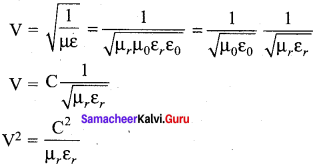
Relative permitivity,

Question 4.
Radiation of energy E falls normally on a perfectly reflecting surface. Find the momentum transferred to the surface.
Solution:
Momentum of radiation of energy E is P = \(\frac { E }{ C }\)
Since the radiation is completely reflected, its momentum changes by \(\frac { 2E }{ C }\)
Therefore, by the law of conservation of momentum the momentum transferred to the surface is \(\frac { 2E }{ C }\).
Question 5.
The energy of the EM wave is of the order of 15KeV. To which part of the spectrum does it belong?
Solution:
E =hv = \(\frac { hc }{ λ }\) ⇒ λ = \(\frac { hc }{ E }\)
h = 6.626 x 10-34 Js; c = 3 x 108 ms-1
E= 15 x 103 eV = 15 x 103 x 1.6 x 10-19 V

λ = 0.8282 x Å
Hence X-rays
Question 6.
Light With an energy flux of 25 x 104 Wm-2 falls on a perfectly reflecting surface at normal incidence. If the surface area is 15cm2, calculate the average force exerted on the surface.
Solution:
Average force = momentum transferred per second
Fav = \(\frac { P }{ T }\) = \(\frac { 2u }{ C }\)
Where U is the energy falling on th surface per second.
Fav = \(\frac{2 \times 25 \times 10^{4} \times 15 \times 10^{-4}}{3 \times 10^{8}}\) = 250 x 10-8
Fav = 2.5 x 10-6 N.
Common Errors And Its Rectifications
Common Errors:
- Students do mistakes most of the time in the unit of frequency. They write the units in improper ways. Eg. Hertz (or) H. This is the wrong way.
- They may confuse the frequency range of radiations and wavelength range of radiation.
Rectifications:
- The correct way of the unit is hertz (or) Hz. The unit of frequency is hertz (or) Hz (or) s-1.
- The easy way to understand the frequency and wavelength range of radiations are, Frequency increases the order of gamma, X-ray, UV, visible, IR, microwave, radio wave.
- Wavelength increases the order of the reverse of frequency order.